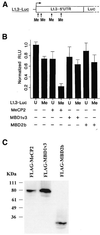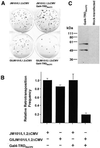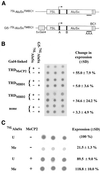Methyl-CpG-binding protein 2 represses LINE-1 expression and retrotransposition but not Alu transcription
- PMID: 11691937
- PMCID: PMC60185
- DOI: 10.1093/nar/29.21.4493
Methyl-CpG-binding protein 2 represses LINE-1 expression and retrotransposition but not Alu transcription
Abstract
In order to explore the defense mechanism by which retrotransposons are repressed, we assessed the ability of methyl-CpG-binding protein 2, MeCP2, to influence LINE-1 (L1) and Alu transcription and, furthermore, L1 retrotransposition. In transient transfection assays, targeting of the transcriptional-repression domain (TRD) of MeCP2 (via a linked Gal4 DNA-binding domain) to the transcriptional start site of L1 promoter-driven reporter constructs efficiently repressed transcription. The Gal4-linked TRD of the related methyl-CpG-binding protein MBD1 also repressed transcription but not that of MBD2. Furthermore, full-length MeCP2 effectively repressed transcription of a HpaII-methylated L1 reporter. Secondly, we used a genetic assay employing a full-length neo-marked L1 reporter construct to study L1 retrotransposition. We found the Gal4-linked TRD of MeCP2 to repress effectively L1 retrotransposition when targeted to the retrotransposition reporter. Retrotransposition was also reduced in response to in vitro HpaII methylation of the reporter and was further decreased by co-expressed full-length MeCP2. In striking contrast expression of the Gal4-linked TRD of MeCP2 had no inhibiting effect on transcription of an AluSx reporter tagged with a 7S-upstream sequence. Furthermore, full-length MeCP2 abrogated the methylation-induced repression of this reporter. Our results indicate that MeCP2 serves a role in repression of L1 expression and retrotransposition but has no inhibiting effect on Alu transcription.
Figures





Similar articles
-
Methyl-CpG binding domain proteins and their involvement in the regulation of the MAGE-A1, MAGE-A2, MAGE-A3, and MAGE-A12 gene promoters.Mol Cancer Res. 2007 Jul;5(7):749-59. doi: 10.1158/1541-7786.MCR-06-0364. Mol Cancer Res. 2007. PMID: 17634428
-
L1 retrotransposition in neurons is modulated by MeCP2.Nature. 2010 Nov 18;468(7322):443-6. doi: 10.1038/nature09544. Nature. 2010. PMID: 21085180 Free PMC article.
-
Methyl-CpG-binding protein MeCP2 represses Sp1-activated transcription of the human leukosialin gene when the promoter is methylated.Mol Cell Biol. 1998 Sep;18(9):5492-9. doi: 10.1128/MCB.18.9.5492. Mol Cell Biol. 1998. PMID: 9710633 Free PMC article.
-
Regulation of transcription and chromatin by methyl-CpG binding protein MBD1.Brain Dev. 2001 Dec;23 Suppl 1:S174-6. doi: 10.1016/s0387-7604(01)00348-5. Brain Dev. 2001. PMID: 11738867 Review.
-
Methyl-CpG-binding proteins. Targeting specific gene repression.Eur J Biochem. 2001 Jan;268(1):1-6. doi: 10.1046/j.1432-1327.2001.01869.x. Eur J Biochem. 2001. PMID: 11121095 Review.
Cited by
-
The Molecular Functions of MeCP2 in Rett Syndrome Pathology.Front Genet. 2021 Apr 23;12:624290. doi: 10.3389/fgene.2021.624290. eCollection 2021. Front Genet. 2021. PMID: 33968128 Free PMC article. Review.
-
Upregulated LINE-1 Activity in the Fanconi Anemia Cancer Susceptibility Syndrome Leads to Spontaneous Pro-inflammatory Cytokine Production.EBioMedicine. 2016 Jun;8:184-194. doi: 10.1016/j.ebiom.2016.05.005. Epub 2016 May 6. EBioMedicine. 2016. PMID: 27428429 Free PMC article.
-
IFI16 Targets the Transcription Factor Sp1 to Suppress HIV-1 Transcription and Latency Reactivation.Cell Host Microbe. 2019 Jun 12;25(6):858-872.e13. doi: 10.1016/j.chom.2019.05.002. Epub 2019 Jun 4. Cell Host Microbe. 2019. PMID: 31175045 Free PMC article.
-
The impact of transposable element activity on therapeutically relevant human stem cells.Mob DNA. 2019 Mar 9;10:9. doi: 10.1186/s13100-019-0151-x. eCollection 2019. Mob DNA. 2019. PMID: 30899334 Free PMC article. Review.
-
Demethylated HSATII DNA and HSATII RNA Foci Sequester PRC1 and MeCP2 into Cancer-Specific Nuclear Bodies.Cell Rep. 2017 Mar 21;18(12):2943-2956. doi: 10.1016/j.celrep.2017.02.072. Cell Rep. 2017. PMID: 28329686 Free PMC article.
References
-
- Kazazian H.H. and Moran,J.V. (1998) The impact of L1 retrotransposition on the human genome. Nature Genet., 19, 19–24. - PubMed
-
- Sassaman D.M., Dombroski,B.A., Moran,J.V., Kimberland,M.L., Nass,T.P., DeBerardinis,R.J., Gabriel,A., Swergold,G.D. and Kazazian,H.H. (1997) Many human L1 elements are capable of retrotransposition. Nature Genet., 16, 37–43. - PubMed
-
- International Human Genome Sequencing Consortium (2001) Initial sequencing and analysis of the human genome. Nature, 409, 860–921. - PubMed
-
- Boeke J.D. (1997) LINEs and Alus – the polyA connection. Nature Genet., 16, 6–7. - PubMed
-
- Woodcock D.M., Lawler,C.B., Linsenmeyer,M.E., Doherty,J.P. and Warren,W.D. (1997) Asymmetric methylation in the hypermethylated CpG promoter region of the human L1 retrotransposon. J. Biol. Chem., 272, 7810–7816. - PubMed
Publication types
MeSH terms
Substances
LinkOut - more resources
Full Text Sources
Other Literature Sources
Molecular Biology Databases
Research Materials
Miscellaneous

